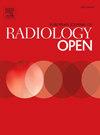Comparison of objective quality parameters between CTA and CTP angiographic reconstructions in ischemic stroke patients
IF 1.8
Q3 RADIOLOGY, NUCLEAR MEDICINE & MEDICAL IMAGING
引用次数: 0
Abstract
Introduction
CT perfusion-angiographic reconstructions (CTP-AR) may be used for occlusion detection in ischemic stroke patients. Objective image quality of CTP-AR needs to be evaluated before implementation as it may affect occlusion detection. In this study, we aimed to assess the objective image quality, by means of contrast to noise ratio (CNR) and signal to noise ratio (SNR), of both CT-angiography and CT perfusion-angiographic reconstructions (CTP-AR).
Methods
Patients with an ischemic stroke between September 2020 up to and including September 2021 who underwent both CT perfusion and CTA at baseline were included. CTP-AR was reconstructed from 1 mm CTP series at the peak arterial enhancement. Per patient, five ipsilateral and five contralateral regions of interest (ROI) were placed. Attenuation and standard deviation per ROI were used to calculate CNR and SNR. Differences in CNR and SNR between CTA and CTP-AR were tested using paired-sample t-tests.
Results
In total, 195/239 patients were included. Both on the ipsilateral and contralateral side, the CNR was significantly higher on CTP-AR compared to CTA (P < .001 and P < .001, respectively). The SNR measured in the M1 was not significantly different between CTA and CTP-AR (ipsilateral: P = .68; contralateral: P = .63). The SNR, both on the ipsilateral and contralateral side, was significantly lower on CTP-AR compared to CTA in all parenchyma regions; the caudate nucleus (P < .001), lentiform nucleus (P < .001), centrum semiovale (P < .001), and the parenchyma adjacent to the M1 (P < .001).
Conclusion
Image quality measures of CTP-derived angiographic reconstructions indicate higher CNR compared to CTA, but a lower SNR in non-angiographic structures.
求助全文
约1分钟内获得全文
求助全文
来源期刊

European Journal of Radiology Open
Medicine-Radiology, Nuclear Medicine and Imaging
CiteScore
4.10
自引率
5.00%
发文量
55
审稿时长
51 days
 求助内容:
求助内容: 应助结果提醒方式:
应助结果提醒方式:


